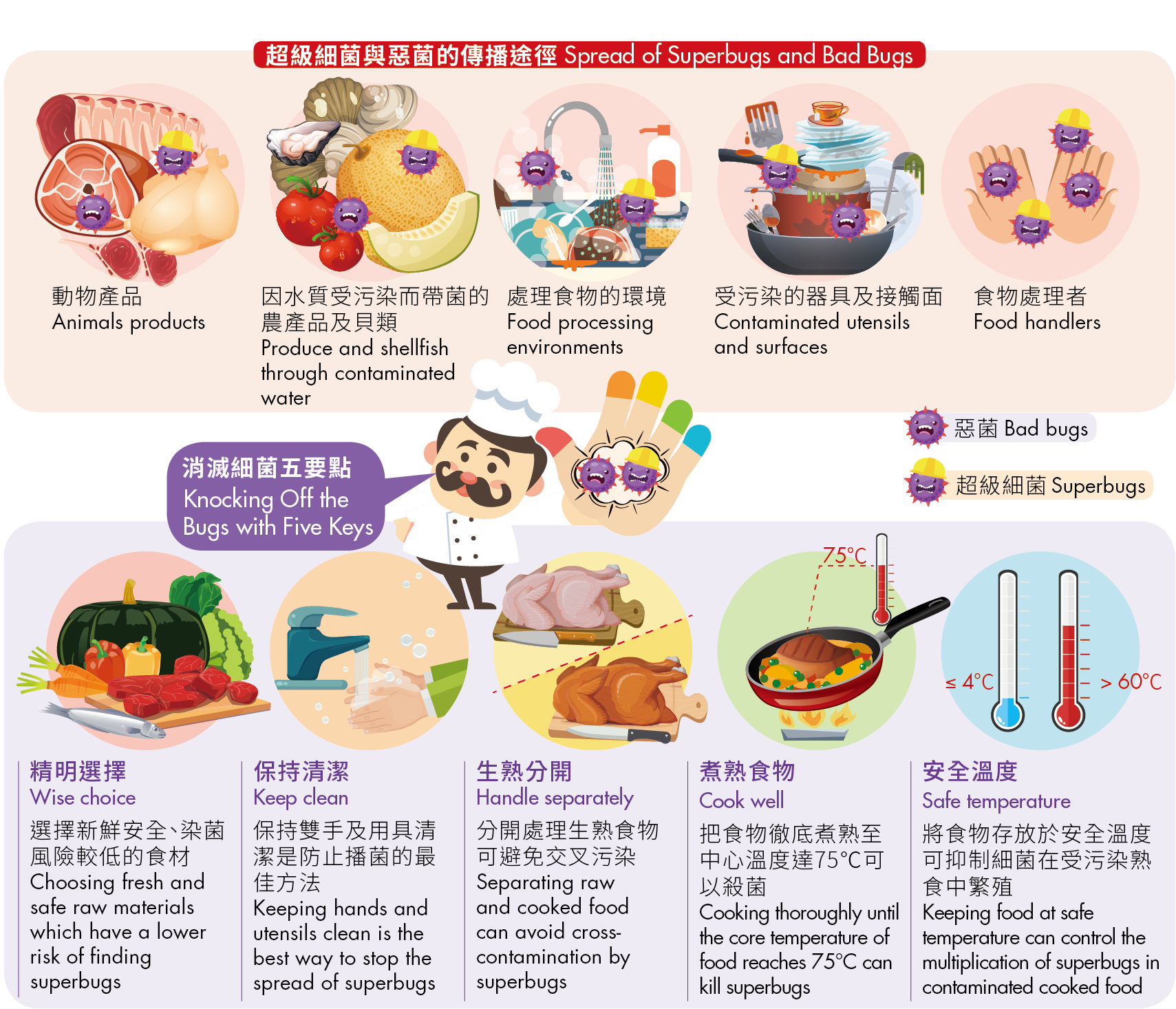
Food Safety Focus (145th Issue, August 2018) – Food Safety Platform
Tackling Superbugs in Foods
Reported by Dr Ken CHONG, Scientific Officer,
Risk Communication Section,
Centre for Food Safety
The spread of antimicrobial resistance (AMR) bacteria in both humans and food-producing animals was discussed in the last issue. From time-to-time, there are media reports on the finding of AMR bacteria in foods or food-producing animals. AMR bacteria are usually highlighted in media report as “superbugs” which generally refer to microorganisms that have developed AMR. People may worry about contracting different types of superbugs in foods. In the second article of this series, we will look into superbugs and relevant preventive measures in relation to food handling.
What Are Superbugs?
Different superbugs have been reported usually due to their resistance to wide range of antimicrobials or to certain last-resort antimicrobials which suggests the emerging threats of treatment failure. They are usually named for their resistance genes or traits together with the microorganisms. Extended-spectrum β-lactamase (ESBL)-producing Enterobacteriaceae is one of the superbugs of concern. β-lactam is a large class of commonly used antibiotics. ESBLs are enzymes that can break down nearly all β-lactams and make them ineffective for treatment.
Superbugs are not necessarily pathogens, and they can also be commensal organisms that have acquired resistance genes. Commensal organisms derive benefits from their association with humans generally without causing harm. Superbugs of commensal organisms are not of no concern, because commensal organisms like Escherichia coli and Enterococcus species, serve as reservoirs of resistance genes that can be transferred to human pathogens transiting the intestinal tract. In addition, commensal organisms sometimes can also be human pathogens, e.g. E. coli is naturally present in our gut but is also a common cause of urinary tract infection and blood stream infection.

Figure: Combating superbugs, as other bad bugs, with 5 Keys to Food Safety.
Finding Superbugs in Food
While infection with superbugs in patients indicates an imminent threat, the finding of superbugs in food-producing animals or animal products (e.g. poultry meat) suggests the spread of AMR. Locally, it was reported that more ESBL-producing E. coli was found in faecal samples from food-producing animals (i.e. cattle, pigs and chickens) than those from cats, dogs and wild rodents. However, it is difficult to compare between the extent of superbugs transmitted via food-producing animals to humans and that via humans to humans due to limited data. That said, the increase in the occurrence of superbugs in food-producing animals is likely to have an influence on human risk. Hence, the monitoring of superbugs in food samples and samples from food-producing animals, in addition to human specimens, is important. The Codex Alimentarius Commission re-established the Intergovernmental Task Force to set guidelines for integrated AMR surveillance. An integrated surveillance on AMR in both humans and animals/animal products can help to identify the trends of and potential threats due to superbugs.
Knocking Off Superbugs with Five Keys to Food safety
Foodborne pathogenic bacteria, i.e. bad bugs, can make you sick while those that are superbugs are more dangerous as treatment options will be limited. Detecting superbugs in foods may raise concern on whether we are having unsafe food or these foods should be thrown away. In fact, cooking food until the core temperature reaching 75°C can kill most bacteria, including both bad bugs and superbugs. Furthermore, observance of good hygienic practices can minimise cross-contamination by both superbugs and bad bugs. That’s why following the 5 Keys to Food Safety (Figure) in daily life for food handling is important for combating superbugs, as well as other bad bugs. In addition, susceptible populations and those who wish to further reduce the risk of foodborne illnesses should avoid consuming raw and undercooked foods which are more likely to carry microorganisms, including superbugs than thoroughly cooked foods.


